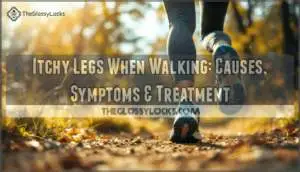This site is supported by our readers. We may earn a commission, at no cost to you, if you purchase through links.

While this reaction might feel alarming, it’s usually your body adjusting to movement after periods of inactivity, though persistent itching can signal underlying conditions ranging from dry skin and fabric allergies to diabetes or eczema.
Understanding what’s driving your discomfort—and recognizing when it warrants medical attention—can help you reclaim the simple pleasure of a walk without distraction.
Table Of Contents
- Key Takeaways
- What Causes Itchy Legs When Walking?
- Recognizing Symptoms of Exercise-Induced Itching
- Common Triggers for Leg Itching While Walking
- Treatment and Prevention Strategies
- When to Seek Medical Attention
- Frequently Asked Questions (FAQs)
- How do I stop my legs from itching when I walk?
- Why does my skin get itchy when I go for a walk?
- What are itchy legs a symptom of?
- Why do my legs get itchy when I walk in the cold?
- Can dehydration contribute to itchy legs while walking?
- Are there specific vitamins that help prevent itchy legs?
- How does altitude affect exercise-induced leg itching?
- Can certain leg exercises reduce itching sensitivity?
- Can exercise-induced itching be permanently cured?
- Does shaving legs worsen itching during walks?
- Conclusion
Key Takeaways
- Approximately 58% of people experience moderate to severe itching during physical activity, primarily caused by histamine release when dormant capillaries suddenly flood with blood during exercise, though this physiological response typically resolves within 10–14 minutes after stopping.
- Persistent leg itching during walking can signal underlying medical conditions including diabetes (with roughly 50% showing neuropathy-related nerve damage), eczema (affecting 91% with moderate-to-severe barrier disruption), or chronic venous disease (impacting 45% of advanced-stage patients).
- Prevention strategies combining moisture-wicking natural fabrics, daily ceramide-rich moisturizers applied within three minutes of bathing, gradual exercise progression, and pre-exercise antihistamines can reduce recurrence by up to 70% after six weeks of consistent implementation.
- Immediate medical attention is required if itching accompanies difficulty breathing, facial swelling, chest pain, dizziness, or symptoms persisting beyond six weeks despite self-care, as these may indicate anaphylaxis, severe allergic reactions, infections, or systemic diseases requiring diagnostic testing.
What Causes Itchy Legs When Walking?
If your legs start to itch during a walk, you’re not imagining things—there are real physiological and environmental reasons behind it. The culprit might be as simple as dry skin or as complex as an underlying medical condition you haven’t yet addressed.
Let’s look at the most common factors that trigger this uncomfortable sensation.
Increased Blood Flow and Histamine Release
When you walk, your leg muscles demand more oxygen, and histamine plays a dual role in that process. This compound, released from mast cells during exercise, triggers vasodilation to boost blood flow by as much as 150% in active tissues. However, histamine also activates TRPV1 signaling pathways and mechanically insensitive C-fibers, which your brain interprets as itching. Histamine impacts exercise performance and recovery.
Here’s what happens:
- Mast cell degranulation releases histamine to aid exercise adaptation and oxygen delivery.
- Histamine vasodilation increases capillary permeability, enhancing nutrient exchange but occasionally provoking pruritus.
- Genetic influence determines your individual susceptibility—some people experience intense leg itch, while others feel nothing at all.
Dry Skin and Environmental Factors
Your skin barrier needs water to function, and environmental factors can strip it away faster than you realize. Low humidity—especially below 30%—accelerates transepidermal water loss by 40–60%, compromising your skin’s protective layer. Winter dryness intensifies this effect, reducing moisture by 20–25%, while cold air and indoor heating drop humidity further.
Skincare habits matter too: hot showers and harsh soaps remove natural oils, increasing dryness by 80%. Age factors in as well—older adults produce 50% less sebum, worsening skin irritation. Cold and dry conditions can greatly impact skin barrier function.
Preventive strategies like daily moisturizing with ceramides can restore hydration and reduce itchy skin considerably.
Allergic Reactions to Clothing or Detergents
Beyond environmental factors, you might be reacting to what touches your legs. Textile dermatitis affects a significant portion of people exposed to certain materials, and you could be sensitized without realizing it. Common culprits include:
- Dye allergens in synthetic fabrics—disperse blue and acid red trigger frequent allergic reactions
- Detergent residues that survive washing cycles, disrupting your skin barrier even at dilutions as low as 1:50,000
- Formaldehyde sensitivity from fabric finishing chemicals, present in roughly 2.5% of tested individuals
Skin irritation from these exposures often manifests as itching during walking when friction, heat, and sweat intensify the allergic response. Pre-washing new garments and choosing natural fibers can reduce your risk of developing a skin rash.
Underlying Medical Conditions (e.g., Diabetes, Eczema)
Sometimes, though, the problem runs deeper than detergent or dry air. Chronic conditions like diabetes, eczema, or chronic venous disease (CVD) frequently produce leg itch during activity.
In diabetic patients, poor glycemic control correlates with itch intensity, and roughly half show signs of neuropathy—nerve damage that triggers pruritic signals. Eczema prevalence reaches 91% moderate-to-severe itch tied to skin barrier disruption, while CVD itch affects about 45% of advanced-stage patients.
Xerosis severity worsens with age and smoking, amplifying these underlying causes when you’re on the move.
Recognizing Symptoms of Exercise-Induced Itching
Exercise-induced itching can feel like a puzzle when you’re just trying to get your steps in. The sensations vary widely—from mild prickling to intense burning—and understanding what’s happening helps you distinguish routine discomfort from something that needs attention.
Let’s break down what you might experience and when those symptoms cross into concerning territory.
Common Sensations and Appearance
You might notice a tingling or prickling sensation creeping up your legs during those initial five to twenty minutes of walking, and for many, that discomfort escalates gradually.
The symptoms of exercise itching include:
- Moderate to severe itching with intensity averaging 6.2 out of 10, affecting 58% of individuals
- Burning or stinging sensations accompanying the itchy feeling in roughly 40% of cases
- Transient redness appearing on your legs in about 35% of presentations
- Raised welts or hives developing in 10–15% of instances with moderate symptoms
Your legs itch with enough intensity to halt activity in approximately 22% of cases, though most episodes self-resolve within ten to fourteen minutes after stopping.
Locations Most Often Affected
When you walk, itching legs most commonly appear on your lower legs, with exercise-induced vasculitis affecting this area in 95% of cases.
The shin symptoms develop in 47% of individuals experiencing runner’s itch, while the popliteal region behind your knees shows exercise-related skin irritation in 42% of cases.
Your thighs experience these symptoms in 36% of presentations, and ankle itching occurs in 25% of episodes, particularly when moisture accumulates during activity.
Symptom Progression During and After Walking
During the first 5 to 10 minutes of activity, you’ll notice early onset itching as blood vessels dilate and histamine release begins, with intensity peaking before circulation stabilizes.
Symptoms generally follow a predictable pattern:
- Mid-exercise itch affects thighs and calves in 60% of cases, often with mild redness appearing 15–30 minutes into your walk
- Post-exercise relief occurs as histamine normalizes within 30–60 minutes, resolving symptoms in over 80% of mild episodes
- Delayed symptoms may emerge 15–45 minutes after stopping, particularly in humid conditions or with synthetic fabrics
Chronic patterns develop in 12–20% of regular walkers, though consistent exercise reduces recurrence in 70% after six weeks.
When Itching Indicates a More Serious Issue
You don’t need to wait for pain to see a doctor—red flag symptoms demand immediate attention. Persistent itching that defies moisturizers and clothing changes, especially when accompanied by systemic warning signs, requires prompt evaluation by your health care provider. Diagnostic tests can reveal underlying conditions like diabetes-related nerve disorders and itching, circulatory problems, or internal diseases that manifest through your skin.
| Red Flag Symptoms | Potential Underlying Conditions | Action Required |
|---|---|---|
| Difficulty breathing, swelling, dizziness | Severe allergic reaction, anaphylaxis | Emergency care immediately |
| Persistent itching despite treatment | Diabetes, kidney disease, liver disorders | Schedule diagnostic tests |
| Itching with skin changes, pain | Venous insufficiency, deep vein thrombosis | Medical evaluation within days |
| Chronic, generalized pruritus | Blood cancers, systemic disease | Thorough workup needed |
Common Triggers for Leg Itching While Walking
Understanding what sets off leg itching during your walks can help you find relief and prevent future episodes. Several factors—ranging from your body’s natural response to exercise to what you’re wearing—can trigger this uncomfortable sensation.
Let’s examine the most common culprits behind exercise-induced leg itching.
Cholinergic Urticaria and Runner’s Itch
When physical activity elevates your core temperature, your body releases histamine to help blood vessel dilation, which can trigger what’s known as cholinergic urticaria or runner’s itch. This condition presents as small, itchy papules surrounded by red halos, usually appearing on your upper chest and neck within 30 minutes of exercise.
- Histamine Mechanisms: Exercise triggers histamine release in affected tissues, causing vasodilation and activating sensory neurons that produce the characteristic pruritic signal
- Urticaria Types: Six distinct reaction patterns exist, with Type I accounting for 83% of exercise-induced urticaria cases and episodes usually resolving within 15–20 minutes
- Treatment Options: Nonsedating antihistamines like fexofenadine or cetirizine effectively manage symptoms of runner’s itch in most cases, with remission rates showing 35.5% of patients symptom-free within five years
Sweat and Heat Exposure
Your skin reacts to heat in unexpected ways during exercise. Sweat composition—largely water with electrolytes—can leak into the dermis when sweat glands malfunction, triggering localized exercise-induced itching through what’s called a "sweat endocrine response."
Heat exposure activates temperature-sensitive receptors that release inflammatory compounds, while the skin microbiome metabolizes sweat components into irritating substances. Temperature fluctuations worsen symptoms, and environmental factors like humidity prevent sweat evaporation, leading to heat rash (miliaria) when ducts become blocked.
Prevention includes moisture-wicking fabrics and proper treatment with emollients to reduce recurrence.
Skin Irritation From Fabrics and Shoes
Beyond heat and moisture, what you wear matters. Textile allergens in synthetic fibers—polyester, nylon, acrylic—trap heat and let disperse dyes migrate onto your skin through sweat, triggering itchy skin in up to 79.8% of allergic cases.
Footwear dermatitis adds another layer: rubber components cause 55.2% of shoe-related reactions, while nickel ornaments and leather tannins affect the foot’s dorsum. Risk groups include those with eczema or psoriasis, whose compromised barriers can’t tolerate these exposures.
Consumer safety starts simple—wash new clothes first to flush formaldehyde and choose breathable natural fibers for symptom relief and effective skin care treatment.
Medication and Pre-existing Skin Conditions
Certain medications carry unexpected risks—drug-induced pruritus affects 5–10% of adverse reactions, with heparin, calcium channel blockers, and antibiotics among the most common culprits. Stopping long-term antihistamine medication like cetirizine paradoxically triggers severe itching in documented cases, sometimes requiring hospitalization.
Pre-existing skin conditions intensify these effects: 60% of atopic dermatitis patients and many with psoriasis experience worsened leg itching during exertion, especially in females and adults aged 50–79, the highest-risk demographic factors.
Treatment and Prevention Strategies
Once you’ve pinpointed what’s making your legs itch during walks, you can take specific steps to ease the discomfort and keep it from happening again. From simple skin care adjustments to medication options, several approaches can help you walk without that nagging urge to scratch.
The following strategies address both immediate relief and long-term prevention.
Moisturizing and Skin Care Tips
At the end of each walk, you’ll want to lock in moisture before your skin has a chance to dry out. Apply emollient creams within three minutes of bathing—this window captures up to 80% more hydration.
Choose barrier repair formulas rich in ceramides and urea, which restore lipid balance and soften rough patches.
Keep shower temperature lukewarm to preserve natural oils, run a humidifier if indoor air feels dry, and moisturize daily to cut itchy skin symptoms by nearly half.
Choosing Appropriate Clothing and Footwear
What you wear during exercise matters more than you might think. Stick with pure cotton or bamboo-derived textiles—they offer enhanced fabric breathability and moisture-wicking capability compared to polyester. Frictionless clothing reduces friction by one-third, while hypoallergenic insoles cut exercise-induced foot itching in over two-thirds of sensitive individuals.
Proper fit prevents chafing, and washing practices using fragrance-free detergents eliminate residue that triggers skin reactions.
Your footwear should ventilate well to prevent sweat accumulation that worsens itching during walks.
Over-the-Counter and Prescription Medications
When itching persists despite preventive measures, you can turn to targeted pharmaceutical interventions. Topical corticosteroids like hydrocortisone reduce inflammation, while antihistamines block histamine-mediated itching—often more effective when combined. Prescription options address refractory cases through immunologic or neural pathways.
- Over-the-counter hydrocortisone creams: Apply one to four times daily for up to seven days to calm inflamed skin
- Nonprescription allergy medicine: Cetirizine or loratadine taken before walking prevents histamine-triggered itch
- Urea-based moisturizers: Formulations at 5–10% concentration deliver a 94.7% reduction in itchiness within 12 hours
- Prescription relief with omalizumab: An anti-IgE monoclonal antibody effectively treats exercise-induced urticaria unresponsive to standard antihistamines
- Adjunctive therapies like mast cell stabilizers: Cromolyn or leukotriene modifiers provide auxiliary benefits for complex or histamine-resistant pruritus
Lifestyle Changes to Reduce Recurrence
Beyond medication alone, sustaining symptom-free walking demands structured lifestyle changes for itchy skin. Exercise habits that build gradually—three to four sessions weekly—improve vascular adaptation and reduce histamine surges by up to 30%.
Hydration strategies, including two to three liters daily and emollient use, maintain skin barrier integrity. Clothing choices favoring breathable natural fibers, temperature control during workouts, and stress management through mindfulness lower recurrence.
These skin care tips collectively address avoiding itch triggers while moisturizing dry skin and reducing stress and anxiety.
When to Seek Medical Attention
Most leg itching during walking resolves with self-care, but certain signs shouldn’t be ignored. Knowing when to contact your healthcare provider can prevent complications and identify underlying conditions early.
Watch for these situations that warrant professional evaluation.
Warning Signs of Severe Allergic Reaction
Although itching may seem minor, you shouldn’t ignore certain red flags that signal anaphylaxis. Up to 98% of anaphylactic reactions begin with skin or mucosal symptoms like hives or throat tightness, but respiratory tract symptoms—wheezing, difficulty breathing—affect around 74–81% of cases.
If you experience chest pain, dizziness, sudden blood pressure drops, or loss of consciousness, immediate epinephrine use and emergency response are critical. Mortality rates reach up to 1,000 U.S. deaths annually when allergy triggers provoke severe anaphylactic reactions without prompt allergy treatment.
Persistent or Worsening Itching
When itching legs persist for more than six weeks or worsen despite your initial efforts, underlying conditions may be driving the symptoms. Chronic pruritus affects roughly 40% of the global population, and treatment failure often signals systemic involvement—kidney disease, liver dysfunction, or medication side effects can all trigger exercise-induced itching.
If your quality of life suffers because causes of itchy legs remain unclear after basic care, a dermatologist can perform blood tests to identify hidden factors and restore comfort.
Associated Symptoms Requiring Prompt Care
When symptoms escalate beyond localized itching, you need to distinguish between benign irritation and urgent medical conditions. A severe allergic reaction—manifesting as generalized flushing, wheezing, or facial swelling—affects up to 50% of individuals with exercise-induced urticaria and demands immediate care.
Infection inflammation symptoms like fever, expanding redness exceeding 5 cm, or elevated skin temperature signal cellulitis requiring prompt antibiotics.
Neurologic sensory warning signs—burning, numbness, or motor weakness—indicate peripheral neuropathy in approximately 8–10% of the population, often linked to circulatory metabolic disorder or uncontrolled diabetes.
If allergy symptoms, chest tightness, or dizziness accompany your itching, contact your health care provider or seek emergency medical advice without delay.
Preparing for a Doctor’s Appointment
Your preparation transforms symptoms into diagnostic clues, enabling your healthcare provider to pinpoint causes efficiently. Gathering specific details about your itching episodes—onset timing, symptom documentation, triggers, and severity—streamlines the evaluation process and accelerates treatment.
Before your medical appointment, compile:
- A symptom diary tracking episode frequency, duration, severity (rated 0–10), and activities for at least seven days
- Complete medication review listing all current prescriptions, over-the-counter products, and recent changes, as drug-related triggers account for approximately 6% of chronic pruritus cases
- Family history documenting allergic reactions, atopy, or skin conditions that influence diagnostic procedures
- Environmental exposures noting detergents, fabrics, footwear, and outdoor allergens associated with flare-ups
Photograph visible skin changes immediately after walking, avoid antihistamines 24–48 hours before your visit unless instructed otherwise, and wear typical exercise clothing to replicate conditions during examination—these steps provide your doctor with actionable medical history for accurate medical advice and targeted treatment.
Frequently Asked Questions (FAQs)
How do I stop my legs from itching when I walk?
Think of your skin as a sleepy network of capillaries suddenly waking up. Stopping that itch means combining cooling techniques, proper hydration strategies, and barrier creams with gradual exposure to exercise.
Treatment for runners itch includes moisture-wicking clothing, post-walk care with emollients, and antihistamines for exercise-induced itching, effectively preventing runners itch and itching legs.
Why does my skin get itchy when I go for a walk?
When you walk, increased blood flow and exercise-induced histamine release trigger vascular adaptation in your legs, causing itching sensations.
Sweat irritation, runners itch, or exercise-induced urticaria may develop, while underlying conditions like neuropathy itching can worsen symptoms during activity.
What are itchy legs a symptom of?
When your legs start to itch, you’re getting a signal from your body. Sometimes it’s just dry skin throwing a tantrum, other times it’s pointing to systemic conditions, skin diseases, nerve disorders, allergic reactions, or medication side-effects that deserve attention.
Why do my legs get itchy when I walk in the cold?
Cold air triggers peripheral vasoconstriction, reducing blood flow and compromising skin barrier function, which leads to dryness and temperature sensitivity.
Your skin’s reaction to sudden rewarming during exercise can cause cold-induced urticaria, making your legs itch despite wearing cold weather gear.
Can dehydration contribute to itchy legs while walking?
Dehydration effects directly influence skin hydration and circulation impact, potentially worsening exercise-induced itching.
When fluid intake drops, sweat composition shifts, electrolyte imbalance develops, and your skin becomes drier, amplifying itching legs symptoms during activity.
Are there specific vitamins that help prevent itchy legs?
Vitamin deficiencies, particularly in B vitamins and vitamin E, can compromise skin health and circulation benefits, potentially worsening itchy skin symptoms.
Nutritional support through supplementation may improve barrier function, though supplement effectiveness varies individually.
Consult your provider for medical advice before starting treatment.
How does altitude affect exercise-induced leg itching?
At high altitude, hypoxia triggers compensatory vasodilation that may intensify exercise-induced itching by increasing blood flow and histamine release.
Reduced sweat production, dry air, and lower barometric pressure further irritate the skin, while altitude-related dehydration amplifies the itch response during physical activity.
Can certain leg exercises reduce itching sensitivity?
Can progressive aerobic conditioning gradually desensitize your itch threshold? Regular exercise promotes neuromuscular adaptation and circulation improvement, which stabilizes blood flow patterns during walking.
This sensory modulation reduces exercise-induced itching symptoms over time, as your vascular system becomes more efficient at managing histamine responses and addressing the physiological demands of movement.
Can exercise-induced itching be permanently cured?
Exercise-induced itching can’t be permanently cured in most cases, but long-term management through preventative measures like regular aerobic training, lifestyle adjustments, and treating underlying conditions effectively controls symptoms of runners itch and exercise-induced skin reactions for sustained relief.
Does shaving legs worsen itching during walks?
Like a fresh blade dancing across terrain, shaving can temporarily disrupt your skin’s protective barrier, increasing irritation, ingrown hairs, and pruritus during exercise.
Razor type, shaving products, and exfoliation effects all influence itchy skin causes, making proper skin care during exercise essential.
Conclusion
Left unchecked, that prickly discomfort could become your body’s way of flagging something more serious down the road—but equipped with the right knowledge, you’re now prepared to distinguish benign adaptation from warning signs that demand attention.
Whether itchy legs when walking stem from sluggish circulation adjusting to movement, fabric friction, or an underlying condition like eczema or diabetes, you’ve got a roadmap for prevention and treatment.
Listen closely to what your skin’s telling you, adjust your routine accordingly, and don’t hesitate to consult a dermatologist if symptoms persist or intensify beyond what feels manageable.










